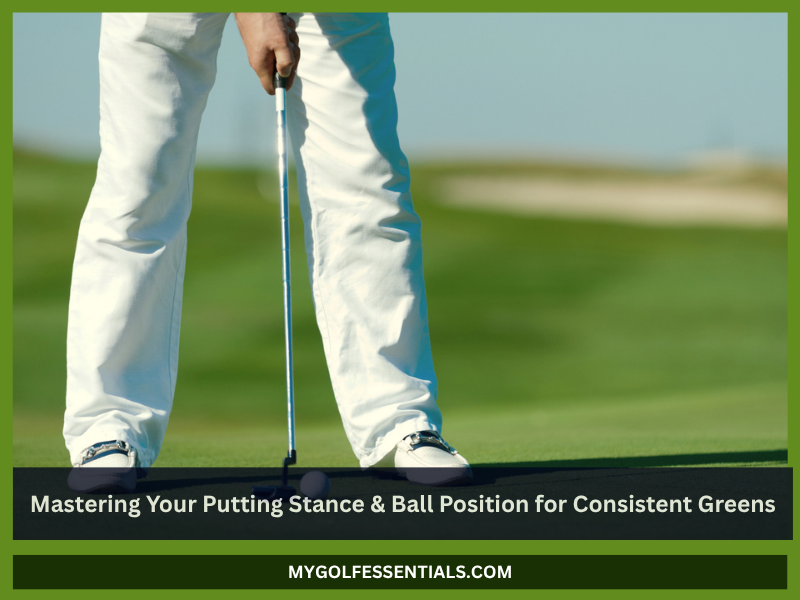
Are you missing short putts that should be easy tap-ins? The issue might not be your putter, it’s likely your putting stance & ball position. These two simple elements can make or break your game on the greens. Even the most expensive equipment won’t help if your foundation isn’t solid.
In this article, we’ll break down exactly how to set up your stance, where to place the ball, and what common mistakes to avoid. You’ll get easy-to-follow golf putting tips that cover the best putting stance, how to fine-tune ball position when putting, and drills to improve putting accuracy.
Whether you’re new to golf or just tired of inconsistent results, this guide will help you dial in your technique and boost your confidence with the flatstick.
Setting Up Your Putting Stance
A reliable setup is the first step to better putting. Without a stable and consistent stance, even a technically sound stroke will produce inconsistent results. That’s why your putting stance & ball position matter so much when you’re trying to sink more putts and lower your scores.
Start with your foot positioning. Your feet should be shoulder-width apart or slightly wider, which gives you a solid base. This setup improves your balance and reduces excess movement during your stroke, which is essential for accuracy and control. This foundation allows you to focus on your stroke without worrying about your lower body shifting during contact.
Next is weight distribution. Many golfers don’t realize that where your weight sits can influence your entire putting motion. Ideally, your weight should be evenly distributed between both feet but with a slight lean toward the balls of your feet.
This slight forward bias promotes a smoother putting stroke and helps prevent your wrists from becoming too active. Keeping your lower body quiet allows your arms and shoulders to do the work, resulting in a more fluid and consistent motion.
Body alignment is just as important. Your shoulders, hips, knees, and feet should all be aligned parallel to your target line. When your upper and lower body are in sync, it becomes easier to swing the putter on your intended line.
Many amateur golfers struggle with misaligned shoulders, which can lead to pushed or pulled putts. Ensuring that your eyes are directly over or just inside the ball will also help you see the line more clearly and make more confident strokes.
With your stance dialed in, you’re halfway to a reliable putting stroke. But your setup won’t be complete unless the ball is placed in the right position. Let’s move on to one of the most common areas golfers overlook.
Determining the Correct Ball Position
The ball’s position in your stance plays a major role in how the putter face contacts it. Too far back or forward, and you could see everything from bouncing putts to off-line rolls. Mastering this aspect of your putting stance & ball position will bring more consistency and feel to your game.
The ideal placement is slightly forward of the center of your stance. This allows the putter to make contact on a slight upward arc, which helps the ball start rolling smoothly instead of skidding.
Many professional coaches, including those at Golf Monthly, recommend placing the ball under your lead eye or just inside it. This ensures your putter is square at impact and encourages better distance and directional control.
Here are a few quick pointers for ideal ball placement:
- Slightly forward of center in your stance
- Aligned with the inside of your lead eye
- Matches the natural low point of your stroke arc
That said, many golfers fall into common ball placement mistakes. Placing the ball too far back in your stance causes you to hit down on the ball, which can lead to hopping and erratic distance. On the other hand, placing it too far forward promotes a glancing stroke, often resulting in weak contact and missed direction.
Another major issue is inconsistency, changing your ball position from putt to putt prevents you from building repeatable muscle memory.
Achieving Proper Posture and Alignment
Once you’ve mastered your putting stance & ball position, the next step is refining your posture and alignment. These elements may seem small, but they have a big impact on your ability to strike the ball consistently and with control.
Many golfers get the stance right but overlook how they hold their upper body and where their eyes sit in relation to the ball.
Start with posture. You should bend from your hips, not your waist so your spine stays straight throughout the motion. A rounded back can lead to tension and restricted movement, while a straight spine promotes a smooth and repeatable stroke.
Lean forward slightly until your eyes are directly over the ball or just inside the line. This head and eye position helps you see the line more clearly, improving your aiming and alignment.
A good putting posture includes:
- Bending from the hips, not the waist
- Keeping your back flat and relaxed
- Positioning your eyes directly over or just inside the ball
- Maintaining soft knees for better balance
Next is arm positioning. Your arms should hang naturally from your shoulders, with little to no tension. This relaxed posture encourages a pendulum-style motion, which is key to improving putting accuracy. Overly stiff arms can cause jerky movements and inconsistent contact, while relaxed arms move freely with your shoulders.
Also, aligning your shoulders parallel to the target line is essential. Many golfers accidentally open their shoulders, which alters the putter’s path. Use alignment tools during practice to develop muscle memory for square shoulders and eye lines.
With your posture and alignment set, your body is ready to execute a smooth and repeatable stroke. But how you hold the putter itself also plays a major role, let’s dive into grip style next.
Selecting the Right Grip
Even with the perfect putting stance & ball position, poor grip technique can throw off your entire stroke. A proper grip gives you control, feel, and stability without adding tension or complexity to your motion. It connects everything you’ve worked on so far, stance, posture, and alignment, and turns them into a confident, repeatable stroke.
First, focus on grip style. Most professionals and instructors recommend a grip that keeps your hands working as a unit. The reverse overlap grip is one of the most common for good reason, it reduces wrist breakdown and promotes a pendulum motion.
This grip involves placing the index finger of your lead hand over the pinky and ring fingers of your trailing hand. It helps quiet the hands and lets your shoulders do the work.
Here are a few grip styles to consider:
- Reverse Overlap Grip – Most common, encourages stability
- Cross-Hand (Left-Hand Low) – Popular among those struggling with wristy strokes
- Claw Grip – Minimizes hand action, good for shaky hands or nervous putters
Grip pressure is just as important. A tight grip creates tension and reduces feel. Instead, aim for light pressure, firm enough to control the club, but soft enough to maintain touch. As GolfComplete.com and Golf Monthly suggest, holding your putter like you would hold a tube of toothpaste without squeezing it is a helpful visual.
With the right grip in place, your stroke becomes smoother, your feel improves, and your consistency rises. But there’s still one final piece that ties everything together, your stroke mechanics and how to practice them effectively. Let’s get into that next.
Practicing for Consistency
You can have the best putting stance & ball position, but without regular practice, your results on the green will stay inconsistent. The key to better putting isn’t just technique, it’s repetition. The more often you reinforce the right setup and motion, the more natural and reliable it becomes under pressure.
Start with alignment drills. Many amateur golfers unknowingly misalign their shoulders, feet, or eyes, even if their stance feels right. Use alignment tools such as chalk lines, alignment sticks, or even a spare club on the ground. These visual cues help you consistently set up square to your target line, making it easier to start the ball on the intended path.
Simple alignment drill:
- Lay down two clubs: one pointing at your target, the other parallel for your feet
- Align your shoulders, hips, and feet to the parallel club
- Practice setting up to the ball without the club first, then step in with your putter
Next, incorporate mirror work into your routine. Practicing in front of a mirror can help you check critical elements like posture, shoulder alignment, and ball position. Are your eyes directly over the ball? Is your putter face square? A mirror gives instant visual feedback, making it easier to spot and fix flaws before they become habits.
Another overlooked factor in putting on a performance is routine. Developing a consistent pre-putt routine anchors your focus and removes uncertainty. Whether it’s a few practice strokes, a specific number of waggles, or visualizing the path before stepping in having a process makes you more confident and steady on the greens.
A solid pre-putt routine might include:
- Checking your alignment from behind the ball
- Taking two calm practice strokes while visualizing the line
- Setting your feet, then aligning your shoulders
- Taking a deep breath before pulling the trigger
Practicing these habits regularly not only helps improve putting accuracy but also builds trust in your setup. And as every golfer knows, confidence on the green is half the battle.
Conclusion
Getting your putting stance & ball position right might seem like a small part of your golf game, but it’s often the difference between a frustrating three-putt and a smooth tap-in. By paying attention to your foot placement, weight distribution, and posture, you’re laying the foundation for a consistent, repeatable stroke.
Combine this solid setup with proper grip, targeted drills, and a reliable routine, and you’ll quickly notice improvements not just in your putting accuracy, but in your overall confidence on the green. These aren’t advanced tricks or complicated theories. They’re simple, proven golf putting tips that work for players at every level.
Now that you know how to dial in your stance, ball position, and practice habits, it’s time to hit the green. Try applying one adjustment at a time and stick with it for a few rounds. You might be surprised how much a slight change in alignment or ball position can lower your scores.
Key Points
- Feet should be shoulder-width apart or slightly wider to create a stable putting stance.
- Distribute weight slightly on the balls of your feet to stay balanced and grounded throughout the stroke.
- Align your shoulders, hips, and feet parallel to the target line for improved accuracy.
Ball position should be slightly forward of center to promote a smooth roll and better contact. - Avoid common mistakes like placing the ball too far back or forward, which can cause inconsistent strokes.
- Bend from your hips, not your back, and keep your eyes directly over the ball for proper posture.
- Let your arms hang naturally with relaxed grip tension to encourage a pendulum-like putting stroke.
- Choose a grip style that unifies your hands, such as the reverse overlap grip, and maintain light pressure.
- Use alignment drills and mirrors to practice setup consistency and correct any flaws in real time.
- Establish a repeatable pre-putt routine to build confidence and maintain consistent habits under pressure.
FAQs
Is there a universal ball position for all golfers?
While slightly forward of center is a common recommendation, individual preferences and stroke styles may necessitate slight adjustments.
How does posture influence ball position?
Proper posture ensures that your eyes are over the ball and that your arms hang naturally, facilitating a consistent stroke and accurate ball positioning.
Can changing ball position help with missed putts?
Yes, adjusting the ball position can correct issues like pulled or pushed putts. Experimenting within a small range can help identify the optimal position for your stroke.



